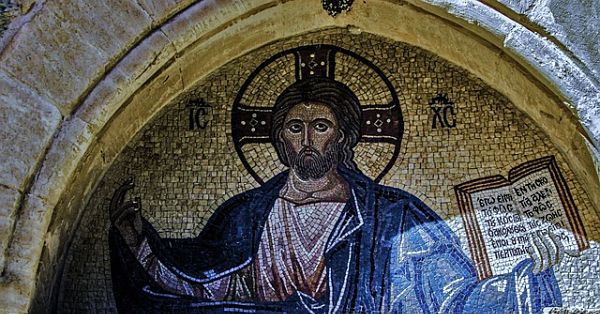 “Some Christians,” David Steinmetz observes — as I wrote this for yesterday’s blog too, “have become concerned about the use of inclusive language in public worship. The traditional reference to God as Father, Son, and Holy Spirit, with its strongly patriarchal overtones, has troubled Christians who feel that more neutral language should be used in the church’s confessions and acts of public worship.” In the essay on inclusive language and the Trinity in his book of essays, Taking the Long View: Christian Theology in Historical Perspective, Steinmetz both examines if the Gloria is an adequate replacement and then examines the history of Trinitarian theology. Today’s post is about the history of that theology.
“Some Christians,” David Steinmetz observes — as I wrote this for yesterday’s blog too, “have become concerned about the use of inclusive language in public worship. The traditional reference to God as Father, Son, and Holy Spirit, with its strongly patriarchal overtones, has troubled Christians who feel that more neutral language should be used in the church’s confessions and acts of public worship.” In the essay on inclusive language and the Trinity in his book of essays, Taking the Long View: Christian Theology in Historical Perspective, Steinmetz both examines if the Gloria is an adequate replacement and then examines the history of Trinitarian theology. Today’s post is about the history of that theology.
But, someone may say, it’s not in the NT. It’s Christian theology and Christian orthodoxy, but not in the NT. Steinmetz responds:
The doctrine of the Trinity is not a biblical doctrine in the sense that it is directly taught in the New Testament. What one finds in the New Testament is the apostolic preaching of a God revealed as Father, Son, and Holy Spirit, together with the ancient confession of Israel that God is one. The doctrine of the Trinity is a product of the church’s reflection on its own proclamation. How can it confess that God is one without obscuring or confusing the threeness of God’s self-revelation? How can it confess that God is three without lapsing into polytheism?
The core of our faith then is to be found in the Creed.
What is the underlying pattern of the Bible? It is summarized in the expanded baptismal confession: “I believe in God the Father Almighty, maker of heaven and earth; and in Jesus Christ his only Son our Lord … [and] in the Holy Spirit.” This confession is regarded as both the underlying structure of the whole Bible and the purest distillate of its teaching. The Bible is about God, Father, Son, and Holy Spirit. Not to interpret it from that perspective is to misinterpret it.
Behind and prior and alongside the Creed were other attempts, attempts that failed.
The conviction that the Bible was to be read in this way left the church face to face with the real trinitarian problem: How were the three names to be reconciled with the confession that God is one? A number of solutions were proposed and found wanting. … The Arians … Sabellius …
The challenge and conversation (and much more) led to the Trinity.
Problems such as these led the church to conclude that the Bible is unintelligible unless God is not only three to us but also three to himself. While there is one God, that God exists in society. Such society is reflected in the historical self-revelation of God and his activity as Father, Son, and Spirit, but is not exhausted by it. Trinity is not merely a doctrine of how God acts; it is a doctrine of who and what God is. Therefore it can only be described by Ianguage appropriate to the verb “is”; namely, the language of being.
Some say, Yes, but this is but Greek language. Steinmetz responds:
The appropriation by the church of metaphysical language about God does not represent a Hellenistic corruption of the simple Hebraic gospel of Jesus and his love.
The Trinity is connected to our sacraments and our redemption:
The dying branches of Adam are cut off by baptism and transplanted into Christ. Because Christ is the Son and therefore fully God, he can serve as the source of life for human beings united to him by faith and baptism. Because Christ is the offspring of Mary and therefore fully human, it is possible for human beings to be so united to him. If he were not human, such a union would be impossible. If he were not God, such a union would be pointless. The Eucharist is the sacrament through which this union is nurtured and perfected. Through the Eucharist the Son is present in his divine nature (the doctrine of the Trinity) and his human natures (the doctrine of the incarnation). As baptism and faith communicated life to the human soul, so, too, the Eucharist by a kind of reverse metabolism communicates life to the human body. Other food is digested by Christian believers, but the Eucharist as a heavenly food digests its own communicants, making them immortal and giving them a share in resurrection life.
What is at stake in the doctrine of the Trinity is not merely an understanding of the nature of God, but a vision of the nature of human salvation.
A brief on Augustine leads to Augustine’s famous analogy to love and this love reveals the heart of Trinitarian theology and the distinction with a Unitarian theory of God:
Probably the most important analogy that Augustine drew was an analogy between the inner life of God and the act of love. The act of loving requires for its completion a lover, a beloved, and the bond of love. In the inner life of the Trinity, the Father is the lover, the Son is the beloved, and the Holy Spirit is the mutual bond of Love that binds them. The use of this analogy had an important consequence for Christian discourse about God. It offered one of the clearest explanations ever conceived of the aseity of God, that is, of the independence of God from creation and of the perfection of God’s life apart from anything outside itself. Just as lovers need nothing but each other and the love that binds them, so God was complete in himself prior to creation, requiring nothing outside himself for his perfection. If that is true, then both creation and redemption are graces, unmerited gifts of God, who needed neither to create nor to redeem. While God cannot will his own nonexistence and cannot exist otherwise than as a Trinity (since that is a matter of nature and not of will), God has an absolute right to create nothing outside himself.
Thus, Creator, Redeemer and Sustainer don’t work. They are about what God does not who God is. They are about operations not ontology.
Not all names of God are trinitarian names; some are names of operations. “Creator,” “redeemer,” “sustainer” are operational or economic names. But trinitarian language is ontological language. It is the language of God’s being, not of God’s doing.
Thus, he says the Creator, Redeemer, Sustainer language, if it is understood as Trinity, is a heresy.
To keep silence in a time of conflict over the doctrine of the Trinity is to commit what Karl Rahner calls “virtual heresy.” To baptize or ordain in the economic names of creator, redeemer, and sustainer is to leave catholic Christianity for an enthusiastic sect.















